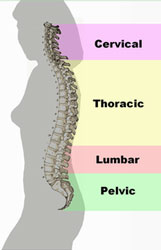






The pain can often be divided into neck pain, upper back pain, lower back pain or tailbone pain. It may have a sudden onset or can be a chronic pain; it can be constant or intermittent, stay in one place or radiate to other areas. It may be a dull ache, or a sharp or piercing or burning sensation. The pain may be radiate into the arm and hand), in the upper back, or in the low back, (and might radiate into the leg or foot), and may include symptoms other than pain, such as weakness, numbness or tingling.
Back pain is one of humanity's most frequent complaints. In the U.S., acute low back pain (also called lumbago) is the fifth most common reason for physician visits. About nine out of ten adults experience back pain at some point in their life, and five out of ten working adults have back pain every year.
Back pain is regularly cited by national governments as having a major impact on productivity, through loss of workers on sick leave. Some national governments, notably Australia and the United Kingdom, have launched campaigns of public health awareness to help combat the problem, for example the Health and Safety Executive's Better Backs campaign.
In the United States lower back pain's economic impact reveals that it is the number one reason for individuals under the age of 45 to limit their activity, second highest complaint seen in physician's offices, fifth most common requirement for hospitalisation, and the third leading cause for surgery.
The spine is a complex interconnecting network of nerves, joints, muscles, tendons and ligaments, and all are capable of producing pain. Large nerves that originate in the spine and go to the legs and arms can make pain radiate to the extremities.
Back pain can be a sign of a serious medical problem, although this is not most frequently the underlying cause:
Back pain does not usually require immediate medical intervention. The vast majority of episodes of back pain are self-limiting and non-progressive. Most back pain syndromes are due to inflammation, especially in the acute phase, which typically lasts for two weeks to three months.
A few observational studies suggest that two conditions to which back pain is often attributed, lumbar disc herniation and degenerative disc disease may not be more prevalent among those in pain than among the general population, and that the mechanisms by which these conditions might cause pain are not known. Other studies suggest that for as many as 85% of cases, no physiological cause can be shown.
A few studies suggest that psychosocial factors such as on-the-job stress and dysfunctional family relationships may correlate more closely with back pain than structural abnormalities revealed in x-rays and other medical imaging scans.
Further reading
Source: Wikipedia